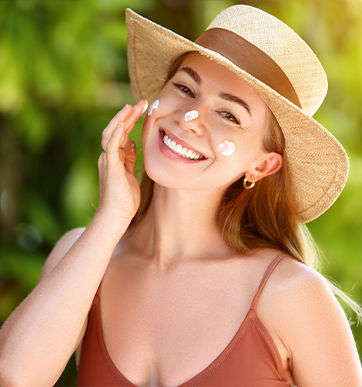
The Hottest Summer Skincare Trend? Sunscreen (Again)!
When it comes to health and beauty, it can be hard to find anything that everyone can agree on year after year. While debates rage, even challenging the long-assumed merits of soap and shampoo, sunscreen seems to be the exception that unites us all — dermatologists, beauty experts, anti-bathers and no-pooers alike.
Sure, the best skin protection is to spend your days indoors and away from windows, but what kind of summer would that be? Sunscreen enables you to get outside with less risk to your skin. However, it will only help keep your skin healthy and beautiful if you choose the right sunscreen and use it correctly. That’s where a little information and effort goes a long way towards keeping your skin healthy and beautiful.
Remember: Tan Is Not Healthy
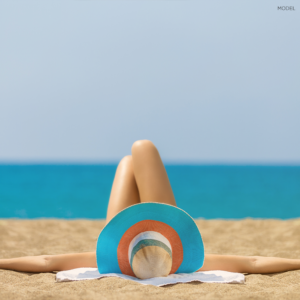 There’s no such thing as healthy sunbathing, no matter what your skin tone. The darkening effect is your skin’s attempt to redistribute melanin to control damage, but damage is being done.
There’s no such thing as healthy sunbathing, no matter what your skin tone. The darkening effect is your skin’s attempt to redistribute melanin to control damage, but damage is being done.
Sun exposure is responsible for an estimated 85% of skin aging, including wrinkles, leathery texture, dark spots and more. Another common outcome is skin cancer. An estimated 1 in 5 Americans will be diagnosed with it during their lifetime, and sometimes it can become deadly. Fortunately, if caught early, most skin cancer can be sent into remission.
Despite the overwhelming evidence that ultraviolet (UV) exposure contributes to premature aging and skin cancer, more than a third of young Americans intentionally tan themselves outdoors, and about 10% of Americans overall. Eight to ten million Americans regularly use tanning beds, and more than half of college students have used one. Protect your skin with sun avoidance, self checking skin spots, and regular exams with a board-certified dermatologist — plus generous sunscreen.
You may be wondering, “But don’t we need to soak up some sunshine to be able to produce vitamin D for strong bones and a sunny mood?” According to the World Health Organization (WHO), 5 to 15 minutes of morning or late-afternoon sun, no more than 3 days per week should be plenty. Better still, take a good calcium and vitamin D3 supplement.
Know Your UV ABCs
A is for aging skin. B is for burns. C is for cancer. The sun’s UV rays do it all — not pretty! For a sunscreen to effectively reduce the negative impact that sun rays have on the skin, it needs to block a broad spectrum of UV rays.
A is for UVA (315 to 399 nm)
Representing about 95% of UV radiation that reaches the ground, these long rays penetrate most deeply into the skin and indirectly affect your DNA. They’re the primary contributor to photoaging and some skin cancers. They can penetrate windows, water and clouds.
B is for UVB (280 to 314 nm)
With shorter wavelengths and higher energy levels, these rays represent 5% of all light that gets past the ozone layer. UVB exposure causes sunburn and other damage, directly harming your DNA and causing most skin cancers. So, despite some claims, no, special UVB-only tanning beds are not safe.
C is for UVC (100 to 279 nm)
While UVC rays are extremely damaging, they are of least concern, because they are completely absorbed by the ozone layer. Certain old-school tanning beds are among your only exposure risks, along with welding torches, mercury lamps and special bacteria-killing light bulbs. Accordingly, no need to worry about these high-energy wavelengths when choosing a sunscreen.
Factors that can amplify the damaging effects of UV rays include:
- Time of day — At midday the sun is closest, so UV rays are strongest because they pass through less atmosphere. One hour of exposure at 9am can be the same as 15 minutes at 1pm.
- Altitude — Similarly, when you’re at a high altitude, the sun is closer so more direct, intense and harmful.
- Weather — Clouds are good at filtering out visible light, but you can’t count on them to do the same to all UV radiation. In fact, cloud cover can sometimes actually reflect and magnify UV rays! Protect yourself on clear and cloudy days.
- Duration — The longer your exposure time, the more solar energy penetrates into your skin.
Make sure your sunscreen is broad spectrum, so it protects against both UVA and UVB light.
Get the FYI on SPF
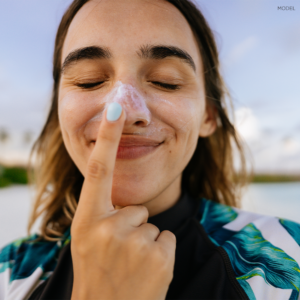 Sun protection factor (SPF) is often misunderstood. Many users will grab a high-SPF sunscreen, apply it once, then feel safe at the beach all day. This false sense of easy invincibility can actually lead to serious sun damage.
Sun protection factor (SPF) is often misunderstood. Many users will grab a high-SPF sunscreen, apply it once, then feel safe at the beach all day. This false sense of easy invincibility can actually lead to serious sun damage.
First, SPF relates to UVB rays only. In order to protect yourself against UVA light too, you need sunscreen with a label that says “broad spectrum” or “full spectrum.” Mexoryl (ecamsule), an ingredient that filters out UVA rays, is close to becoming generally available in the United States. Currently, however, these are the three UVA filters to look for:
- Zinc oxide – Physically blocks against wavelengths all the way from short UVBs to long UVAs.
- Titanium dioxide – Also a physical block, it gives good protection against UVBs and some UVAs.
- Avobenzone (Parsol 1789) – Filtering out rays ranging from 310 nm to 400 nm, it’s the only chemical ingredient on this list. Unfortunately, it loses 50–90% of its potency within the first hour unless it’s combined with certain UVB absorbers — usually octinoxate or octocrylene, which are harmful to animals, coral reefs and the environment.
Second, it’s easy to assume that SPF 100 provides more than three times the protection as SPF 30. But, it does not. In reality, SPF 30, SPF 50 and SPF 100 block roughly 97%, 98% and 99% of UVB rays, respectively. Accordingly, Europe, Australia, Canada and Japan cap SPF claims at 50+ to avoid confusion.
Third, how you use sunscreen makes all the difference. You won’t receive its full protection unless you:
- Apply it liberally – Use roughly one ounce — or a full shot glass — in addition to what’s needed to coat your face.
- Reapply it often – Most sunscreens recommend reapplication every one to two hours. You’ll need to touch up sooner if it has a lower SPF number, or if you’re sweating or swimming.
- Choose a product you love – A sunscreen you don’t wear provides ZERO SPF!
Find the Right Sunscreen for You
The American Academy of Dermatology recommends that you choose a broad-spectrum sunscreen with a minimum of 30 SPF. In the United States, the majority of safe, stable, lasting products that fit the bill feature zinc oxide, often in combination with titanium dioxide. If you’re worried that these mineral ingredients will leave you with a white cast, rest assured that they’ve come a long way. You’re sure to find products you enjoy.
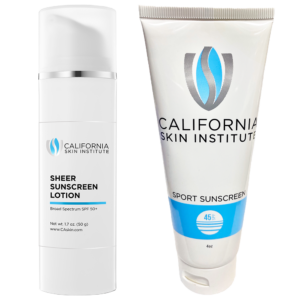 A good place to start is with CSI Sheer Sunscreen SPF 50+ Lotion. The gentle, weightless formula makes it an easy daily staple, alone or under makeup. Besides offering broad-spectrum protection, it treats skin with antioxidants including green tea polyphenols, resveratrol, emblica, CoQ10, and vitamins A, C and E. If you need your sunscreen to endure some water and sweat, CSI Sport Sunscreen 45 SPF boasts staying power that’s non-comedogenic.
A good place to start is with CSI Sheer Sunscreen SPF 50+ Lotion. The gentle, weightless formula makes it an easy daily staple, alone or under makeup. Besides offering broad-spectrum protection, it treats skin with antioxidants including green tea polyphenols, resveratrol, emblica, CoQ10, and vitamins A, C and E. If you need your sunscreen to endure some water and sweat, CSI Sport Sunscreen 45 SPF boasts staying power that’s non-comedogenic.
Many modern mineral sunscreens not only provide UVA/UVB protection, but can multitask as a cosmetic. Colorescience Even Up® Clinical Pigment Perfector® SPF 50 Sunscreen and CSI Physical Tinted BB Cream SPF 30 Sunscreen both work like a primer to blur uneven skin tone while they protect against further discoloration by the sun. Colorescience also makes the powder Sunforgettable® Total Protection™ Brush-On Shield SPF 50, which you can use in place of a tinted dry foundation. Their Sunforgettable® Total Protection™ Sheer Matte SPF 30 Sunscreen Brush is great to bring along for powder touch-ups throughout the day.
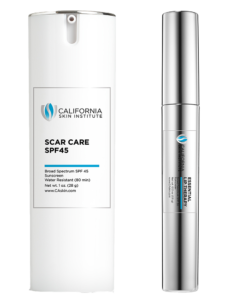 After a procedure like laser resurfacing, a chemical peel or surgery, you need sun protection more than ever. Make sure your sunscreen is formulated for skin to breathe and heal, while helping prevent the sun from exacerbating scarring and pigmentation changes. Scar Care SPF45 can even be applied to open wounds, and it soothes with potent antioxidants.
After a procedure like laser resurfacing, a chemical peel or surgery, you need sun protection more than ever. Make sure your sunscreen is formulated for skin to breathe and heal, while helping prevent the sun from exacerbating scarring and pigmentation changes. Scar Care SPF45 can even be applied to open wounds, and it soothes with potent antioxidants.
Whatever you do, don’t forget your lips! Essential Lip Therapy with 30 SPF uses chemical UVA/UVB filters to protect them, while plumping and hydrating with hyaluronic acid, peptides and ceramides.
Make Sunscreen Your #1 Summer Accessory
During the summer, it can be hard to stay out of the sun entirely, no matter how serious you are about keeping your skin healthy and beautiful. If you do get some UV exposure, see a board-certified dermatologist to catch any early signs of cancer. They can also recommend treatments like laser, chemical peels and microdermabrasion to reduce the signs of sun damage.
However, the best strategy is to prevent damage in the first place. Sit in the shade, wear a brimmed hat, long sleeves and sunglasses, and constantly apply and reapply a high-quality, broad-spectrum sunscreen with SPF of 30 or higher.


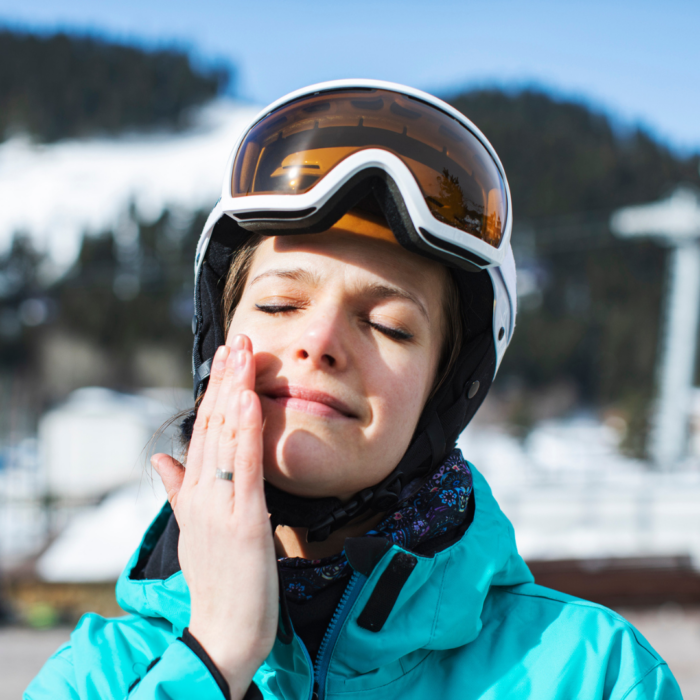
 / 291 Reviews
/ 291 Reviews